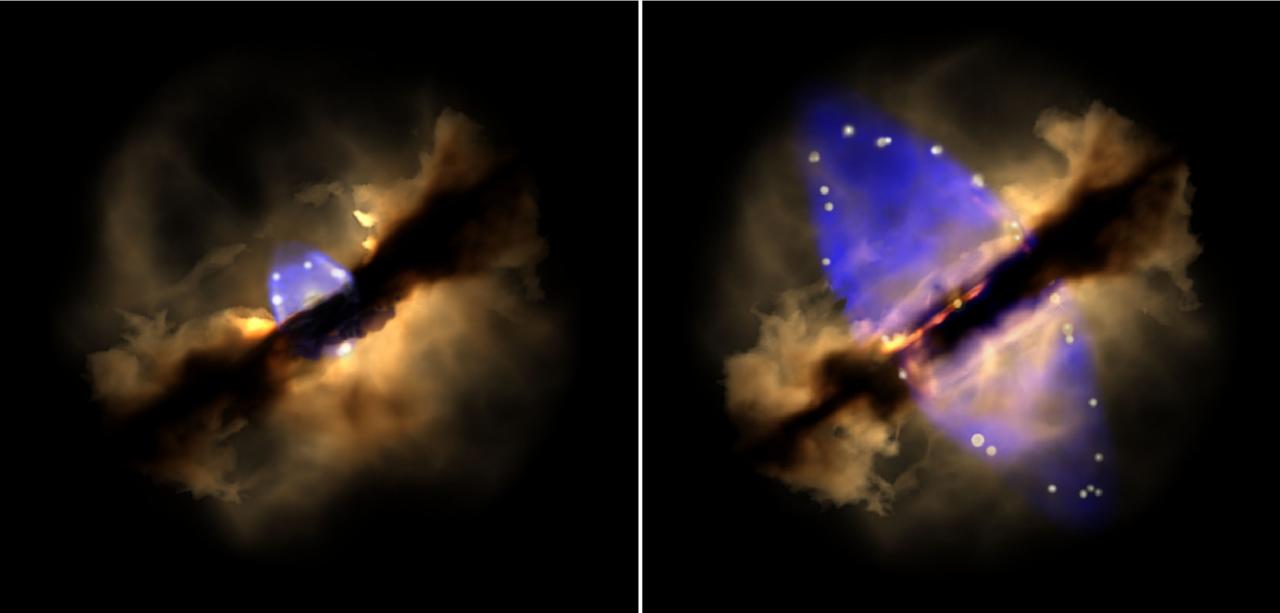Emergence of a stellar jet observed in real time
The observation over an eighteen year span of the formation of a massive star has unveiled the birth of a bipolar jet which ejects matter and regulates the star’s growth
Stars are formed inside great clouds of gas and dust from patches of higher density that collapse under the pull of their own gravity. A disk then forms around this original embryo from which the star continues to gather new material while at the same time ejecting matter and energy through a bipolar jet.
The phenomenon of collimated matter ejection –jets– is common to different astronomical objects such as young stars, black holes in galaxy nuclei or stars in the last stages of their lives, but it is still unknown how it originates and what determines the degree of collimation. A group of international astronomers has been able to observe the moment in which star W75N(B)-VLA2 began to develop these fundamental features of stellar formation.
The study, published in Science magazine and involving researchers from the Institut de Ciències de l’Espai (ICE-CSIC/IEEC)-Institut de Ciències del Cosmos (ICC-UB) and the Institute of Astrophysics of Andalusia (IAA-CSIC), was led by Carlos Carrasco-González (UNAM, Mexico).

Formation of a jet in a massive proto-star. Hydro-dynamic and three-dimensional simulation and visualization, generated using the Shape code, of a short episodic ejection on massive proto-star W75N (B)-VLA 2. The initial ejection in various directions (left panel) turns into a collimated ejection (right panel) as it expands into a toroidal distribution of gas and dust. (Image: Wolfgang Steffen, Institute of Astronomy, UNAM).
MONITORING THE EVOLUTION OF A PROTOSTAR "IN REAL TIME"
The study shows how W75N(B)-VLA2, a massive star in the course of formation, has drastically changed the way in which it expels matter, from a virtually spherical form to an elongated ejection along a single axis. Although stellar formation processes last hundreds of thousands of years, in this case researchers have witnessed the evolution toward the formation of a jet in the span of only eighteen years, from 1996 to 2014.
"Current theories predict that young stars should eject matter in collimated jets. But earlier studies had shown us that some very young massive stars go through short periods where they eject matter in all directions. We suspected that at some moment there should be a transition to the phase of high collimation. That transition is exactly what we are witnessing on W75N(B)-VLA2”, says Guillem Anglada, IAA-CSIC researcher taking part in the study.
The data obtained are also consistent with the existence of a disk around the proto-star, which confirms the scenario of stellar formation described in the models. “Our work offers a unique opportunity to study how the basic ingredients of stellar formation evolve in this region in the next few years. We are lucky to be present just at the right moment to be able to monitor and describe these rapid changes in real time” concludes José María Torrelles, CSIC-IEEC / ICC-UB-IEEC researcher participating in the study.
C. Carrasco-González, J.M. Torrelles, J. Cantó, S. Curiel, G. Surcis, W.H.T. Vlemmings, H.J. van Langevelde, C. Goddi, G. Anglada, S.-W. Kim, J.S. Kim, J.F. Gómez"Observing the onset of outflow collimation in a massive protostar". Science.
Instituto de Astrofísica de Andalucía (IAA-CSIC)
Unidad de Divulgación y Comunicación
Silbia López de Lacalle - sll[arroba]iaa.es - 958230532
http://www.iaa.es
http://divulgacion.iaa.es

